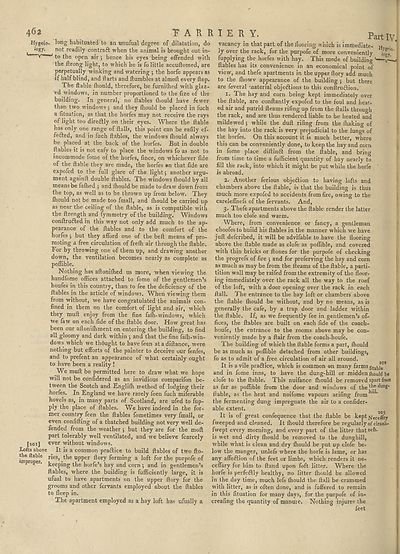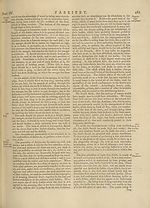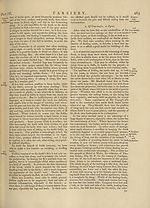Encyclopaedia Britannica, or, a Dictionary of arts, sciences, and miscellaneous literature : enlarged and improved. Illustrated with nearly six hundred engravings > Volume 8, ELE-FOR
(492) Page 462
Download files
Complete book:
Individual page:
Thumbnail gallery: Grid view | List view

462 T A R R
Hygeio- 5ong habituated to an unufual degree of dilatation, do
. io^y- n°t readily contract when the animal is brought out in-
v— 0pen ajr . jience jjjg ey€S being offended with
the ftrong light, to which he is fo little accuftomed, are
perpetually winking and watering $ the horfe appears as
if half blind, and darts and Humbles at almofl every ftep.
The flable fhould, therefore, be furnifhed with glaz¬
ed windows, in number proportioned to the fize of the
building. In general, no flables fliould have fewer
than two windows ; and they fhould be placed in fuch
a fituation, as that the horfes may not receive the rays
of light too diredlly on their eyes. Where the liable
Hygeio.
logy.
I E R Y. partlv>
vacancy in that part, of the flooring which is immediate¬
ly over the rack, for the purpofe of more conveniently
fupplying the horfes with hay. This mode of building
flables has its convenience in an economical point of
view, and thefe apartments in the upper flory add much
to the fhowv appearance of the building j but there
are feveral material objeftions to this conftrudtion.
i. The hay and corn being kept immediately over
the flable, are conflantly expofed to the foul and heat*
ed air and putrid fleams rifing up from the flails through
the rack, and are thus rendered liable to be heated and
mildewed ; while the dull rifing from the fhaking of
t20X]
Lofts above
the liable
improper.
has only one range of flails, this point can be eafily ef- the hay into the rack is very prejudicial to the lungs of
febled, and in fuch flables, the windows fhould always the horfes. On this account it is much better, where
be placed at the back of the horfes. But in double
flables it is not eafy to place the windows fo as not to
incommode fome of the horfes, fince, on whichever fide
of the flable they are made, the horfes en that fide are
expofed to the full glare of the light; another argu¬
ment againfl double {tables. The windows fhould by all
means be fafhed j and fhould be made to draw down from
the top, as well as to be thrown up from below. They
fliould not be made too fmall, and fhould be carried up
as near the ceiling of the flable, as is compatible with
the ftrength and fymmetry of the building. Windows
conflrudled in this way not only add much to the ap¬
pearance of the flables and to the comfort of the
horfes; but they afford one of the befl means of pro¬
moting a free circulation of frefh air through the flable.
For by throwing one of them up, and drawing another
down, the ventilation becomes nearly as complete as
poflible.
Nothing has aflonifhed us more, when viewing the
handfome offices attached to fome of the gentlemen’s
houfes in this country, than to fee the deficiency of the
{tables in the article of windows. Wlien viewing them
from without, we have congratulated the animals con¬
fined in them on the comfort of light and air, which
they mufl enjoy from the fine faffi-windows, which
we faw on each fide of the flable door. How great has
been our afloniffiment on entering the building, to find
all gloomy and dark within j and that the fine fafh-win-
dows which we thought to have feen atadiflance, were
nothing but efforts of the painter to deceive our fenfes,
and to prefent an appearance of what certainly ought
to have been a reality!
We mufl be permitted here to draw what we hope
will not be confidered as an invidious comparifon be¬
tween the Scotch and Engliffi method of lodging their
horfes. In England we have rarely feen fuch miferable
hovels as, in many parts of Scotland, are ufed to fup-
ply the place of flables. We have indeed in the for¬
mer country feen the flables fometimes very fmall, or
even confifling of a thatched building not very well de¬
fended from the weather $ but they are for the mofl
part tolerably well ventilated, and we believe fcarcely
ever without windows.
It is a common pradlice to build flables of two fto-
ries, the upper flory forming a loft for the purpofe of
keeping the horfe’s hay and corn ; and in gentlemen’s
flables, where the building is fufficiently large, it is
ufual to have apartments on the upper flory for the
grooms and other fervants employed about the flables
to fleep in.
The apartment employed as a hay loft has ufually a
this can be conveniently done, to keep the hay and corn
in fome place diflindl from the liable, and bring
from time to time a fufficient quantity of hay nearly to
fill the rack, into which it might be put while the horfe '
is abroad.
2. Another ferious objedlion to having lofts and
chambers above the flable, is that the building is thus
much more expofed to accidents from fire, owing to the
carelefihefs of the fervants. And,
3. Thefe apartments above the liable render the latter
much too clofe and warm.
Where, from convenience or fancy, a gentleman
choofes to build his flables in the manner which we have
juft defcribed, it will be advifable to have the flooring
above the liable made as clofe as poffible, and covered
with thin bricks or Hones for the purpofe of checking
the progrefs of fire 5 and for preferving the hay and corn
as much as may be from the fleams of the liable, a parti-
tition wall may be raifed from the extremity of the floor¬
ing immediately over the rack all the way to the roof
of the loft, with a door opening over the rack in each
flail. The entrance to the hay loft or chambers above
the flable fhould be without, and by no means, as is
generally the cafe, by a trap door and ladder within
the liable. If, as we frequently fee in gentlemen’s of¬
fices, the flables are built on each fide of the coach-
houfe, the entrance to the rooms above may be con¬
veniently made by a flair from the coach-houfe.
The building of which the liable forms a part, fhould
be as much as poffible detached from other buildings,
fo as to admit of a free circulation of air all around.
It is a vile praflice, which is common on many farms
and in fome inns, to have the dung-hill or midden fliould be
clofe to the liable. This nuifance ftiould be removed apart frera
as far as poffible from the door and windows of the|^®(*unS*
flable, as the heat and noifome vapours arifing from"1
the fermenting dung impregnate the air to a confider-
able extent.
It is of great confequence that the liable be kept^reCgg{fy
fweeped and cleaned. It fliould therefore be regularly of cleanh-
fwept every morning, and every part of the litter thatnefr*
is wet and dirty fhould be removed to the dunghill,
while what is clean and dry fhould be put up clofe be¬
low the manger, unlefs where the horfe is lame, or has
any affe6lion of the feet or limbs, which renders it ne-
ceflary for him to fland upon foft litter. Where the
horfe is perfectly healthy, no litter fhould be allowed
in the day time, much lefs ffiould the flail be crammed
with litter, as is often done, and is fuffered to remain
in this fituation for many days, for the purpofe of in-
creafing the quantity of manure. Nothing injures the
feet
Hygeio- 5ong habituated to an unufual degree of dilatation, do
. io^y- n°t readily contract when the animal is brought out in-
v— 0pen ajr . jience jjjg ey€S being offended with
the ftrong light, to which he is fo little accuftomed, are
perpetually winking and watering $ the horfe appears as
if half blind, and darts and Humbles at almofl every ftep.
The flable fhould, therefore, be furnifhed with glaz¬
ed windows, in number proportioned to the fize of the
building. In general, no flables fliould have fewer
than two windows ; and they fhould be placed in fuch
a fituation, as that the horfes may not receive the rays
of light too diredlly on their eyes. Where the liable
Hygeio.
logy.
I E R Y. partlv>
vacancy in that part, of the flooring which is immediate¬
ly over the rack, for the purpofe of more conveniently
fupplying the horfes with hay. This mode of building
flables has its convenience in an economical point of
view, and thefe apartments in the upper flory add much
to the fhowv appearance of the building j but there
are feveral material objeftions to this conftrudtion.
i. The hay and corn being kept immediately over
the flable, are conflantly expofed to the foul and heat*
ed air and putrid fleams rifing up from the flails through
the rack, and are thus rendered liable to be heated and
mildewed ; while the dull rifing from the fhaking of
t20X]
Lofts above
the liable
improper.
has only one range of flails, this point can be eafily ef- the hay into the rack is very prejudicial to the lungs of
febled, and in fuch flables, the windows fhould always the horfes. On this account it is much better, where
be placed at the back of the horfes. But in double
flables it is not eafy to place the windows fo as not to
incommode fome of the horfes, fince, on whichever fide
of the flable they are made, the horfes en that fide are
expofed to the full glare of the light; another argu¬
ment againfl double {tables. The windows fhould by all
means be fafhed j and fhould be made to draw down from
the top, as well as to be thrown up from below. They
fliould not be made too fmall, and fhould be carried up
as near the ceiling of the flable, as is compatible with
the ftrength and fymmetry of the building. Windows
conflrudled in this way not only add much to the ap¬
pearance of the flables and to the comfort of the
horfes; but they afford one of the befl means of pro¬
moting a free circulation of frefh air through the flable.
For by throwing one of them up, and drawing another
down, the ventilation becomes nearly as complete as
poflible.
Nothing has aflonifhed us more, when viewing the
handfome offices attached to fome of the gentlemen’s
houfes in this country, than to fee the deficiency of the
{tables in the article of windows. Wlien viewing them
from without, we have congratulated the animals con¬
fined in them on the comfort of light and air, which
they mufl enjoy from the fine faffi-windows, which
we faw on each fide of the flable door. How great has
been our afloniffiment on entering the building, to find
all gloomy and dark within j and that the fine fafh-win-
dows which we thought to have feen atadiflance, were
nothing but efforts of the painter to deceive our fenfes,
and to prefent an appearance of what certainly ought
to have been a reality!
We mufl be permitted here to draw what we hope
will not be confidered as an invidious comparifon be¬
tween the Scotch and Engliffi method of lodging their
horfes. In England we have rarely feen fuch miferable
hovels as, in many parts of Scotland, are ufed to fup-
ply the place of flables. We have indeed in the for¬
mer country feen the flables fometimes very fmall, or
even confifling of a thatched building not very well de¬
fended from the weather $ but they are for the mofl
part tolerably well ventilated, and we believe fcarcely
ever without windows.
It is a common pradlice to build flables of two fto-
ries, the upper flory forming a loft for the purpofe of
keeping the horfe’s hay and corn ; and in gentlemen’s
flables, where the building is fufficiently large, it is
ufual to have apartments on the upper flory for the
grooms and other fervants employed about the flables
to fleep in.
The apartment employed as a hay loft has ufually a
this can be conveniently done, to keep the hay and corn
in fome place diflindl from the liable, and bring
from time to time a fufficient quantity of hay nearly to
fill the rack, into which it might be put while the horfe '
is abroad.
2. Another ferious objedlion to having lofts and
chambers above the flable, is that the building is thus
much more expofed to accidents from fire, owing to the
carelefihefs of the fervants. And,
3. Thefe apartments above the liable render the latter
much too clofe and warm.
Where, from convenience or fancy, a gentleman
choofes to build his flables in the manner which we have
juft defcribed, it will be advifable to have the flooring
above the liable made as clofe as poffible, and covered
with thin bricks or Hones for the purpofe of checking
the progrefs of fire 5 and for preferving the hay and corn
as much as may be from the fleams of the liable, a parti-
tition wall may be raifed from the extremity of the floor¬
ing immediately over the rack all the way to the roof
of the loft, with a door opening over the rack in each
flail. The entrance to the hay loft or chambers above
the flable fhould be without, and by no means, as is
generally the cafe, by a trap door and ladder within
the liable. If, as we frequently fee in gentlemen’s of¬
fices, the flables are built on each fide of the coach-
houfe, the entrance to the rooms above may be con¬
veniently made by a flair from the coach-houfe.
The building of which the liable forms a part, fhould
be as much as poffible detached from other buildings,
fo as to admit of a free circulation of air all around.
It is a vile praflice, which is common on many farms
and in fome inns, to have the dung-hill or midden fliould be
clofe to the liable. This nuifance ftiould be removed apart frera
as far as poffible from the door and windows of the|^®(*unS*
flable, as the heat and noifome vapours arifing from"1
the fermenting dung impregnate the air to a confider-
able extent.
It is of great confequence that the liable be kept^reCgg{fy
fweeped and cleaned. It fliould therefore be regularly of cleanh-
fwept every morning, and every part of the litter thatnefr*
is wet and dirty fhould be removed to the dunghill,
while what is clean and dry fhould be put up clofe be¬
low the manger, unlefs where the horfe is lame, or has
any affe6lion of the feet or limbs, which renders it ne-
ceflary for him to fland upon foft litter. Where the
horfe is perfectly healthy, no litter fhould be allowed
in the day time, much lefs ffiould the flail be crammed
with litter, as is often done, and is fuffered to remain
in this fituation for many days, for the purpofe of in-
creafing the quantity of manure. Nothing injures the
feet
Set display mode to:
![]() Universal Viewer |
Universal Viewer | ![]() Mirador |
Large image | Transcription
Mirador |
Large image | Transcription
Images and transcriptions on this page, including medium image downloads, may be used under the Creative Commons Attribution 4.0 International Licence unless otherwise stated. ![]()
| Permanent URL | https://digital.nls.uk/192269815 |
|---|
| Attribution and copyright: |
|
|---|
| Description | Ten editions of 'Encyclopaedia Britannica', issued from 1768-1903, in 231 volumes. Originally issued in 100 weekly parts (3 volumes) between 1768 and 1771 by publishers: Colin Macfarquhar and Andrew Bell (Edinburgh); editor: William Smellie: engraver: Andrew Bell. Expanded editions in the 19th century featured more volumes and contributions from leading experts in their fields. Managed and published in Edinburgh up to the 9th edition (25 volumes, from 1875-1889); the 10th edition (1902-1903) re-issued the 9th edition, with 11 supplementary volumes. |
|---|---|
| Additional NLS resources: |
|

